Historically, scientists have relegated glycogen in the brain to a mere energy reserve, with its primary functions confined to the liver and muscles. This perspective, while convenient, overlooked the intricate and dynamic role that glycogen might play within neural tissue. Recent groundbreaking research challenges this traditional view, suggesting that glycogen is not just a passive energy store but an active participant in neuronal health and disease. Recognizing this could fundamentally transform our approach to neurodegenerative diseases like Alzheimer’s, opening pathways to novel and more effective treatments.
Far from being a simple backup system, glycogen appears to be entangled in the complex pathology of neurodegeneration. Evidence indicates that excessive glycogen accumulation correlates with tau pathology, a hallmark of Alzheimer’s disease. Such accumulation isn’t merely incidental; it suggests an active process where glycogen interacts with pathological proteins, exacerbating neuronal damage. If glycogen’s role extends beyond energy supply and into disease progression, then manipulating its metabolism could lead to groundbreaking therapeutic strategies.
Unraveling the Interaction Between Tau Proteins and Glycogen
The connection between tau protein build-up and glycogen dynamics is a revolutionary insight. In disease models using fruit flies and human brain tissue, researchers have observed that when tau proteins malfunction, they interfere with the normal breakdown of glycogen. This disruption leads to a harmful cascade: glycogen accumulates excessively, and neurons become less resilient to stressors such as oxidative damage. The evidence points to a vicious cycle—tau pathology hampers glycogen utilization, which in turn fuels further neuronal degeneration.
This discovery pivots the focus from merely addressing tau accumulation to targeting metabolic processes within neurons. By understanding how tau impairs glycogen breakdown, scientists can explore strategies to restore balance. An interesting aspect is the role of glycogen phosphorylase (GlyP), an enzyme that catalyzes glycogen degradation. Its activity appears pivotal; boosting GlyP levels in experimental models reduced glycogen buildup, aiding neurons in detoxifying reactive oxygen species and preserving cell integrity.
Metabolic Interventions as Potential Game Changers
What stands out about these findings is the potential to harness metabolic pathways through relatively straightforward interventions. Dietary modification, specifically low-protein diets, has been shown to extend lifespan and reduce brain damage in tauopathy models. This suggests that metabolic flexibility—the brain’s ability to efficiently manage and utilize glycogen—can be enhanced through lifestyle choices.
Moreover, researchers have developed a drug analog—8-Br-cAMP—that mimics the beneficial effects of dietary restriction. Its success in experimental models underscores the possibility of pharmaceutical remedies to modulate glycogen metabolism. Such drugs could potentially recalibrate neuronal energy management, preventing or slowing degenerative processes.
Adding to this optimism is the intriguing connection with existing medications like GLP-1 receptor agonists. Drugs such as Ozempic, originally aimed at managing diabetes and promoting weight loss, are now showing promise for neurodegeneration. They appear to interact with pathways linked to glycogen regulation, providing a compelling example of how existing therapeutics can be repurposed into neuroprotective agents.
Reimagining Alzheimer’s Treatment: A Metabolic Revolution
This evolving understanding of glycogen’s role signals a seismic shift in the fight against neurodegenerative diseases. Instead of focusing solely on amyloid and tau proteins, future strategies could encompass metabolic reprogramming—enhancing the brain’s inherent ability to manage energy and detoxify harmful substances. Such an approach could lead to treatments that not only slow disease progression but also restore neuronal resilience.
The implications are profound. If glycogen management within neurons proves to be a controllable factor, early intervention could delay or prevent the pathological cascade that leads to dementia. It challenges the prevailing paradigm and invites us to view neurodegeneration not merely as a biochemicalopathy but also as a metabolic disorder—a puzzle that might be solvable through targeted metabolic therapies.
This paradigm shift emphasizes an optimistic future where metabolic health and neuronal longevity are intertwined. As research advances, harnessing the brain’s intrinsic energy systems might become the cornerstone of neurodegenerative disease treatment, revolutionizing how we approach conditions that currently have no cure.


Leave a Reply